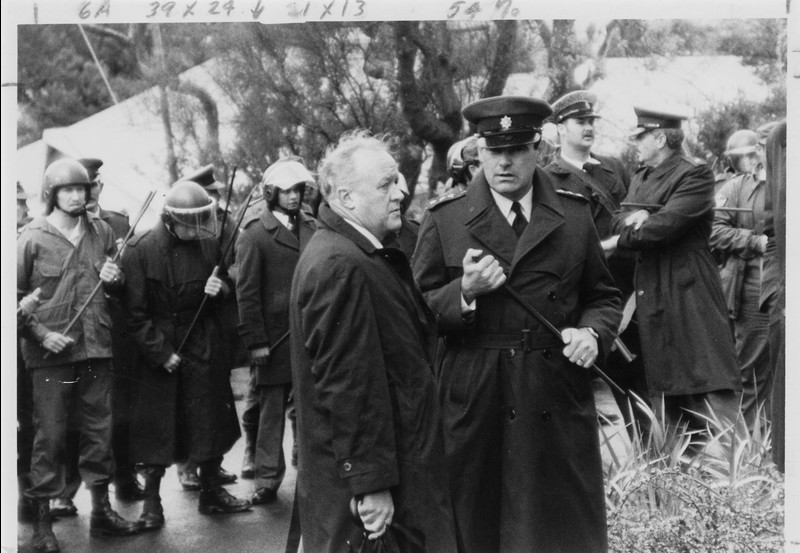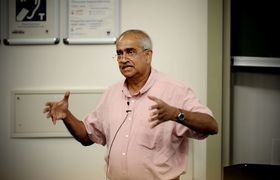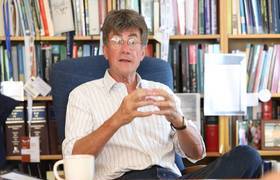‘We always felt that he had our backs’ – former SRC members reflect
17 February 2021 | Story Helen Swingler. Photo University of Cape Town. Read time >10 min.
Past members of the University of Cape Town’s (UCT) Students’ Representative Council (SRC) and National Union of South African Students (NUSAS) reflect on Dr Stuart Saunders’ leadership during a pivotal stage in the history of the country and the university. Dr Saunders passed away on 12 February 2021 after a short illness.
Dr Geordie Ractliffe is a freshwater ecologist, teacher and sustainability education practitioner. She was an SRC member from 1986 to 1989 and SRC president in 1989.
“I was a typical white upper-middle class student at UCT in 1984, opposed to apartheid but with zero understanding of systemic racism and exploitation – the ‘incurable structural contradictions’ of the South African state. The 1985 State of Emergency, as it rolled out in the acrid smoke of teargas, the popping of rubber bullets and the chant of thousands of voices in snaking toyi-toyi marches, was a time of intense politicisation that defined my life and changed the outlook of most students I know from that time, even those not taken up with student activism.
“Stuart Saunders managed and represented UCT in the early and mid-80s in an era where most white South Africans, even most liberals, did not support an unqualified universal franchise, and where the liberal opposition’s notion of political change was premised on (white) parliamentary initiative, thus framing and controlling the nature of ‘reform’.
“In our view, the university was pushed to redress the worst of the inequities faced by black students – accommodation, academic exclusions, financial aid.”
“UCT was a white institution, which was increasingly challenged by the growing black student population, who refused to be co-opted into its unrepresentative structures. The (white) Students’ Representative Council, as an affiliate of the United Democratic Front-aligned NUSAS, worked in a principled non-racial alliance with the South African National Students Congress (SANSCO) in separate, parallel, racially constituted student organisations, a situation reflected also in the residences and in sport.
“Saunders received intense criticism from members of the UCT Council and beyond for tolerating these ‘apartheid’ structures. This ‘racial parallelism’ did not … sit comfortably with the white student body but was a deliberate strategy that created the space for political work at the interface of black–white student experience.
“From our student activist perspective, Saunders represented an undemocratic institution and was not an ally. In our view, the university was pushed to redress the worst of the inequities faced by black students – accommodation, academic exclusions, financial aid – only through the vehemence and radicalism of the struggles of black students and their refusal to legitimise the institution.
“Despite bitter battles within, Dr Saunders sought to understand black and white student leaders.”
“And yet, ironically, it was Saunders’ principled and unwavering commitment to our right to struggle that saw him place his body on the line between ourselves and the riot police, on the barricades of anti-apartheid protest, demanding the sanctity of the university campus, contracting with lawyers to represent detained students, keeping us safe. This was no mean feat. The university under Saunders’ leadership used its privilege to allow a political voice, in a time of mass-banning of grassroots organisations and in a time when white South Africans were fed a diet of rooi-en-swart-gevaar (red-and-black-danger) propaganda.
“Despite bitter battles within, Dr Saunders sought to understand black and white student leaders. Who will forget the braais (barbecues) at Glenara, the Monday morning check-ins in the VC’s office attended by us with a mixture of inadequacy (he was never unclear about his agenda, so we needed to be prepared about ours) and scepticism (that he was doing anything more than manipulate), but also gratitude to feel we had a voice.
“Many years later at a student government reunion, we saw in Dr Saunders’ emotional reminiscence his view of us. Never, he said, before or after, had he witnessed greater courage in the face of a powerful enemy than that shown by the student leadership of the 80s. In many ways, the times – and possibly the effect that we had on him – may have made him a greater person, a better leader than he might otherwise have been. And greatness was what we needed then (and what we need now).”
Cameron Dugmore is the Leader of the Opposition in the Western Cape Provincial Parliament and was SRC president in 1987/88.
“Dr Saunders led UCT in a very turbulent time in our country’s history. As students, we were determined to do all we could to mobilise and organise our constituency and work with the broader anti-apartheid movement to bring down the apartheid government. Dr Saunders often found himself between us and the riot police.
“We always felt that he had our backs and did whatever he could to prevent harm coming our way.”
“It was clear that he also faced pressure from conservative elements on the UCT Council, Senate and the donor community. Despite all these pressures, we always felt that he had our backs and did whatever he could to prevent harm coming our way. He was a wily negotiator who managed to keep our university together – contradictions and all. He was a brave and principled patriot. May his soul rest in peace.”
Michael Briggs works in the United Kingdom with local authorities and other public sector organisations to shape and deliver strategic projects and programmes. He was SRC vice-president in 1988/89.
“His legacy is carried out into the world by the many who benefited from his stewardship and is embedded in the DNA of the institution.”
“This is a tribute to the principled and caring leadership given by Stuart Saunders during our time at UCT in the mid to late 80s. Inevitably, as VC during tumultuous times, he was sometimes the object of student protest. We remember the songs calling him to act on fees, exclusions, accommodation and other issues, which continue to challenge universities to this day. At the same time, he tenaciously defended our right to protest. He worked to maintain the university as a space where truth is spoken to power and where the academic project is never complacent.
“History will reflect that he played a visionary role in building a bridge to the future for an institution that continues to transform the lives of students who pass through it, and which contributes so much to wider society.
“Ultimately, as students, we always knew that Stuart Saunders had our back. Many of us will reflect on the example of his leadership during challenging times. His legacy is carried out into the world by the many who benefited from his stewardship and is embedded in the DNA of the institution, which he did so much to prepare for the journey ahead.”
“I am grateful for his courage and leadership in dark times.”
Renée Alberts was a member of the SRC from 1985 to 1987.
“As NUSAS lefties in the 80s, Stuart Saunders was not seen as one of us. Marching on the admin [building] was maybe an easier target than the brutal apartheid state, but we knew that ultimately, when up against the apartheid state, he had our backs.
“Two occasions stand out for me. After weeks of skirmishes with the police on De Waal Drive, the message came that if we marched, the police would not hesitate to use live ammunition. When the meeting decided to march, there was a very different feeling in the air. Dr Saunders met us as we left upper campus and walked at the front, our vice-chancellor shield.
“On another occasion, during the dark days of the State of Emergency, the security police turned up at Green Level. They went around the room, commenting on each person in turn. One of them turned to me and said, ‘And you, you will be coming with us now.’ The boot of my car was packed with ANC pamphlets, which we had planned to leave around campus later that day.
“I knew that when I went with them, I would not be going home for a long time. At that moment, Dr Saunders marched into the room, shaking off his umbrella, and demanded to know what was going on. ‘They say I have to go with them,’ I told him. ‘Don’t you have a lecture that you should be in?’ Dr Saunders barked. ‘Students should be in lectures, not hanging around here.’ I jumped up and ran.
“I am grateful for his courage and leadership in dark times.”
 This work is licensed under a Creative Commons Attribution-NoDerivatives 4.0 International License.
This work is licensed under a Creative Commons Attribution-NoDerivatives 4.0 International License.
Please view the republishing articles page for more information.










